RESEARCH
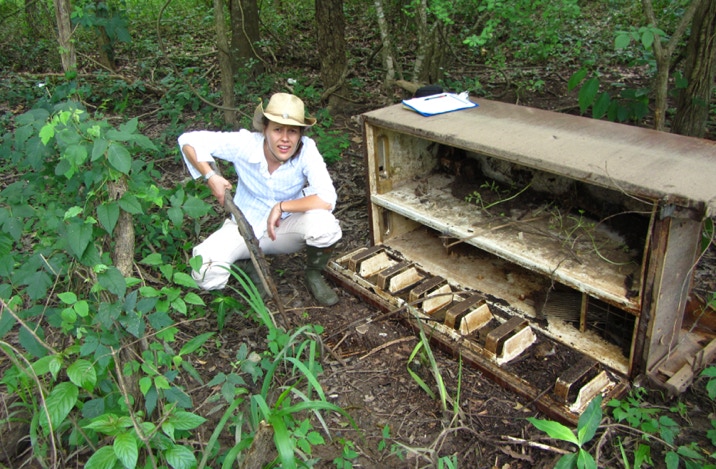
CURRENT PROJECTS
THE GENETIC BASIS OF ADAPTIVE TRAITS IN AQUILEGIA
The evolution of nectar spurs on petals in Aquilegia (columbine) is seen as an important factor in the recent and rapid radiation of the genus as the evolution of these nectar spurs promotes interactions with different animal pollinators. Variation in a number of floral traits, including spur length, floral color, and floral orientation contribute to reproductive isolation between columbine species. I use genomic tools such as whole-genome and transcriptome sequencing to study the genetic basis of these traits in both an evolutionary and developmental context. I am also interested in how variation in these traits affects the ecology of the organisms. Several current projects are described below:
Mapping floral traits influencing reproductive isolation between closely related species with different animal pollinators, A. formosa and A. pubescens
Funding: NIH NRSA Fellowship
A. formosa is a a primarily hummingbird pollinated species with medium length nectar spurs (see figure below). A. pubescens is a relatively long-spurred species pollinated primarily by hawk moths (see figure below). A. formosa has a widespread distribution across western North America (CA, NV, OR, WA, AK, B.C.) while A. pubescens is restricted to several small populations located at high elevations in the central Sierra Nevada mountain range (CA). We used high-throughput sequencing to sequence the genome of ∼350 F2 offspring of a genetic cross between A. formosa and A. pubescens that was created using an outcross design (two A. formosa alleles and two A. pubescens alleles segregating in the F2 generation). I used this low coverage genome sequencing to map recombination breakpoints to within 5 kb in order to identify the genomic regions associated with variation in spur length, color, and floral orientation. Interestingly, our outcross design revealed within species variation at many of the loci controlling the floral variation between these species. A single locus appears to control most of the variation in anthocyanin pigment (the red pigment of A. formosa) production between the two species and this locus has within species variation in its effect on phenotype. Three R2R3 MYB transcription factors with homology to those known to regulate anthocyanin production in many other angiosperms underlie the QTL for spur color. One of these MYBs, MYBC, has several alleles predicted to result in loss or reduced function segregating in A. pubescens populations. Knocking down the expression of MYBC using Virus Induced Gene Silencing (VIGS) results in reduced anthocyanin pigment production in the horticultural variety A. coerulea ‘origami’ (see figure below). Future studies aim to study the phenotypic effects of the different A. pubescens MYBC alleles.


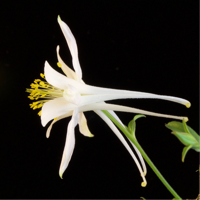

A. formosa (left) is primarily pollinated by hummingbirds. A. pubescens (right) is primarily pollinated by hawk moths.
Below: Knocking down MYBC expression using VIGS results in reduced pigment production.

Identifying loci crucial to nectar spur development in Aquilegia using a species that lost its spurs, A. ecalcarata
Funding: Harvey Karp Discovery Award, NSF
A. ecalcarata is the only species of columbine lacking nectar spurs. The phylogenetic position of A. ecalcarata indicates that spurs have been secondarily lost in this species. Classic crosses between A. ecalcarata and spurred species conducted by Prazmo in the 1960s suggest that spur loss segregates in a Mendelian fashion and is controlled by one recessive locus. In the ∼75% of F2 offspring that have nectar spurs, spur length varies. Using ~300 F2 individuals, I mapped the locus controlling spur loss to a 1 cM non-recombining region containing ~1000 genes. I used RNA sequencing to assess gene expression in the petals of 3 spurred species (A. sibirica, A. formosa, and A. chrysantha) and A. ecalcarata at 5 early developmental stages. Of the ~1000 genes in the QTL for spur loss, only 9 are consistently on a higher levels in the spurred species versus A. ecalcarata. One of these genes, which we call POPOVICH (POP) also shows differential expression between the developing spur and blade portions of petals. Using RNAseq to analyze gene expression in A. sibirica x A. ecalcarata F2s, I showed that the difference in the expression of POP between A. sibirica and A. ecalcarata is due to differences in cis-regulation. Examining the expression of POP throughout petal development shows that it is expressed during the mitotic phase of spur development and is turned off as mitosis ceases and spur growth continues via anisotropic cell growth. Using Virus Induced Gene Silencing (VIGS) to knock down the expression of POP in a spurred species results in nectar spurs with truncated growth (see below).
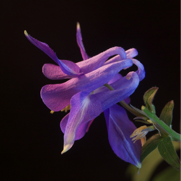
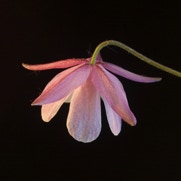
To identify loci crucial to nectar spur development, we crossed a spurred species, A. sibirica (left), to the only spurless Aquilegia species, A. ecalcarata (right)
A. sibirica
A. ecalcarata
A. sibirica x A. ecalcarata F2s
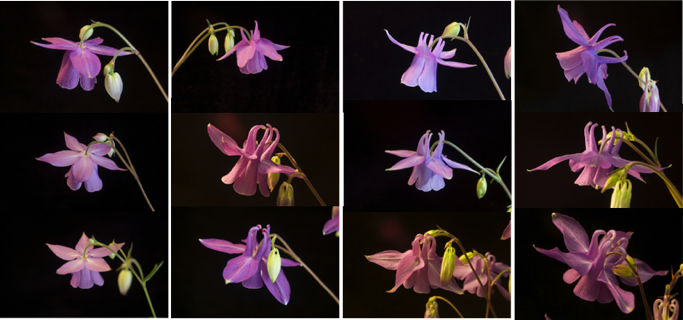
The ratio of spur-less (left column) to spurred plants (right three columns) in the F2 generation is 1:3, indicating that spurloss is controlled by a recessive allele at a single locus. Using a combination of QTL mapping using whole-genome sequencing and comparative gene expression using RNAseq, I identified a gene candidate in this QTL that we call POPOVICH (POP).
POP is crucial to nectar spur development. Knocking down POP expression using VIGS results in petals with truncated spurs (right, knockdown petals are white, wild type petals are red).
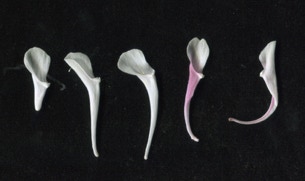
POP knock-down using VIGS

knock down
wild type



Identifying the genetic basis of floral traits differentiating sister species with different animal pollinators, bee pollinated A. brevistyla and hummingbird pollinated A. canadensis
While there have been a number of shifts from hummingbird pollination to hawk moth pollination in North American columbines, there have only been two shifts from bee to hummingbird pollination. One of these shifts is captured by the sister species pair of A. brevistyla and A. canadensis (see images below). These species differ in a number of floral traits including floral color and spur shape. In order to understand the how these differences evolved, I intend to use a combination of QTL mapping, gene expression, and population genetics to identify the loci crucial to floral differentiation between these species. I have recruited two PhD students in the Kramer Lab at Harvard University, Molly Edwards and MinYa, who are interested in the genetic and developmental basis of traits that vary between these species (spur curvature and meristem size, respectively) to assist with the QTL mapping aspect of this project. The first steps of the QTL mapping experiment are underway with F2 seedlings beginning to germinate. In the summer of 2017, Molly and I collected population samples of A. brevistyla in the Canadian rockies following the Pan-American Society for Evolutionary and Developmental Biology conference in Calgary, AB. Thanks to Dr. Billie Gould for providing A. canadensis seed and members of the Alberta Native Plant Council for providing A. brevistyla seed in order to make the initial F1 cross.
A. canadensis

F1 hybrid

A. brevistyla
PAST PROJECTS
LOUISIANA IRISES: GENETICS AND HYBRID ZONE DYNAMICS
The Louisiana Irises are a well-known system used for studying the effects of hybridization on the evolution of species. I guided several projects aimed at improving genomic resources in this system in which genetic studies are hampered by an exceedingly large genome (1N = 10 Gb) with a high-level of repetitive elements. This work included directing transcriptome sequencing of three Iris species (I. fulva, I. brevicaulis, and I. hexagona) using high-throughput sequencing technologies in order to develop a large number of SNP markers (Ballerini et al., 2013). Using these markers, I created genetic recombination maps across these three species (Ballerini et al., in review), upon which the genetic regions controlling various traits influencing reproductive isolation were identified using quantitative trait locus mapping (Ballerini et al., 2012; Brothers et al., 2013).
My colleague, Dr. Amanda Brothers, and I then used these markers to address a number of important questions in a hybrid zone between I. fulva and I. brevicaulis in southern Louisiana including: Are certain regions of the genome more or less porous to introgression? Is there evidence for adaptive introgression of particular genomic regions from one species to another? Is this potential introgression dependent on environmental factors? This project allowed me to provide field training to first year University of Georgia (UGA) graduate student Jenna Hamlin and UGA undergraduates Babajide Aderinwale and Josh Foley as we collected ecological data including soil moisture content, elevation, and shade cover for ~500 plants in a hybrid zone and genotyped these plants using the SNP markers I developed. We are currently analyzing these data to identify associations between genotype, ecological factors, and introgression patterns of these markers considering the genome architecture of the previously identified quantitative traits.
FLOWERING TIME IN AQUILEGIA FORMOSA
My graduate research focused on elucidating the flowering time pathway in Aquilegia formosa with the goal of understanding how this developmental pathway has diversified across angiosperms. Because timing the transition from vegetative to reproductive growth (flowering) can have a large bearing on fitness, a complex network of regulatory pathways has evolved to regulate this transition in response to both endogenous (e.g., plant age or size) and exogenous (e.g., light and temperature) cues. I characterized the basic environmental factors controlling flowering in A. formosa and found that vernalization, or an extended period of cold treatment (mimicking winter), generated a strong flowering response but changes in photoperiod did not (Ballerini and Kramer, 2011a). This finding indicates that these plants control seasonal flowering by responding to temperature fluctuations rather than to photoperiod.
I additionally described developmental changes at the plant apex during the floral transition using histological sectioning, a project that provided an opportunity for me to mentor Harvard undergraduate Elena Butler. These studies revealed that in A. formosa, the floral transition occurs during the vernalization treatment, rather than following vernalization treatment, a finding that differs from the flowering phenomenon in the model plant Arabidopsis. I further characterized the floral transition in Aquilegia through gene expression studies, analyzing the expression of flowering time candidate genes identified in Arabidopsis in response to photoperiod and vernalization using qRT-PCR and in situ hybridization. As expected based on the environmental response studies, these analyses indicated that the photoperiod genetic pathway (involving the genes GIGANTEA, CONSTANS, and FLOWERING LOCUS T) does not appear to be conserved between Arabidopsis and Aquilegia, however, several downstream genes controlling floral development (LEAFY) likely have conserved roles (Ballerini and Kramer, 2011a). These findings challenged the longstanding theory that the photoperiod pathway is conserved across deep divergences in the angiosperms (Ballerini and Kramer, 2011b).
Vernalization response in angiosperms has likely evolved multiple times and little is known about the evolution of this response across angiosperms. The vernalization response in Arabidopsis involves stable changes in gene expression following vernalization via heterochromatic remodeling at key loci. In order to identify candidate genes regulating the vernalization response in A. formosa, I conducted global transcriptome analyses comparing gene expression before and after vernalization using RNAseq. Several differentially regulated genes identified by this analysis are homologs to those known to function in epigenetic regulatory pathways in Arabidopsis, suggesting that the vernalization response in Aquilegia may also be regulated by epigenetic processes. Together, these analyses comprise a solid platform for the continuing study of the genetic basis of flowering time in Aquilegia.